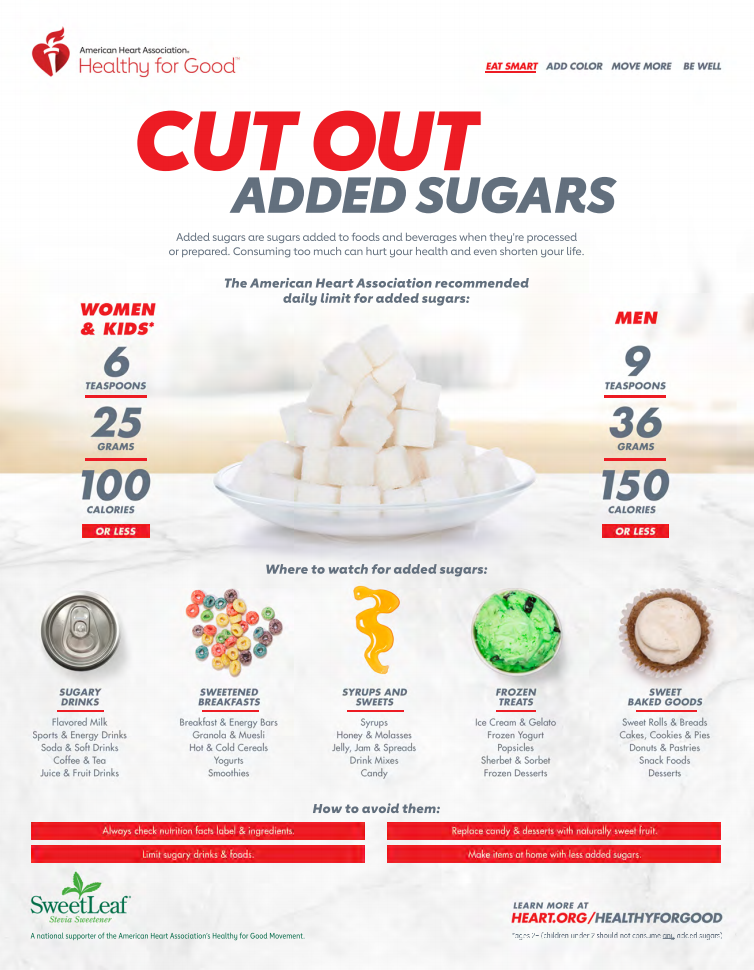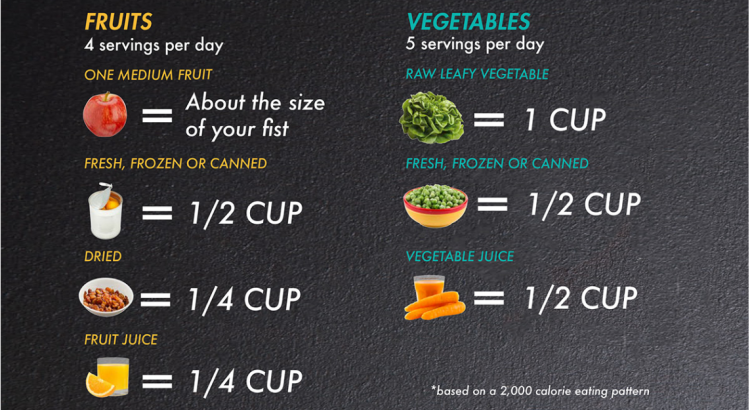+ Eat Vegetables and Fruits (4 or more servings of vegetables and 3 or more of fruits) and Avoid Added Sugars
Fresh vegetables and fruits are the foundations of a healthy diet and successful weight loss. Most processed foods, sweets and non-diet sodas contain a lot of calories in just a small portion. Vegetables and fruits are the opposite – they have lots of bulk (fiber) and few calories. You can eat a lot, consume fewer calories and feel full at the end of your meal. The American Heart Association recommends eating 4 servings of vegetables and 3 servings of fruit every day.
Your first reaction to seeing how many servings of vegetables and fruit you should eat might have been, “I can’t do that!” Hold on – you may be confusing servings with portions. A portion is the amount of food YOU put on your plate; which may contain many servings. One of the reasons many Americans today are overweight or obese is that portion sizes have increased; especially in restaurants. We’ve become accustomed to eating large amounts of food at our meals – far more than we actually need. To lose weight, and keep it off, you need to learn how to estimate servings so you can control portions.
This month, the challenge is to eat more servings of vegetables and fruits. And you may find that focusing on eating more veggies and fruits (a very positive, health improvement habit) will distract you from having to say NO to highly processed, high-calorie junk food. Use the following tips to plan how you can increase your chances of increasing your daily vegetable and fruit intake.
- Be selective. Eat only those vegetables and fruits that you like, but don’t be afraid to explore different types and varieties. You may be surprised.
- Make them #1. Vegetables should take up the largest portion of your lunch and dinner plates, with fruits trailing close behind. East these foods first, rather than reserving them for the end of the meal.
- Consider them a priority. When planning meals, think of dishes that contain vegetables and fruits as the centerpiece and build the rest of your meal around them.
- Mix it up. Try both raw and cooked vegetables. Lightly cook, steam or roast vegetables for a softer texture.
- Grab-and-Go. When you’re in a hurry, have ready-to-eat vegetables and fruits on hand. Buy fresh vegetables and fruits that require little preparation, such as baby carrots, cherry tomatoes, bananas, apples and grapes.
- Think toppings. Add bananas, strawberries or other fruit to cereal or yogurt.
- Explore. Visit local farmers markets. The freshness and variety may encourage you to try new kinds of produce.
- Innovate. Find ways to incorporate vegetables with other foods or in existing recipes. Add them to soups, casseroles, pizzas and sandwiches.
Stay on track with your vegetable and fruit intake each day to avoid added sugars found in processed foods. Added refined sugars contains extra (unwanted) calories, has no nutritional value, and negative health effects such as tooth decay and an increase in blood sugar (glucose) associated with diabetes. If you want something sweet use the natural sweetness of fruit. Instead of sugar on your cereal add banana, blueberries or strawberries. Blend fresh (or frozen) fruit with frozen yogurt and ice for a refreshing and naturally sweet treat and for dessert, prepare baked apples or grilled pineapple.

